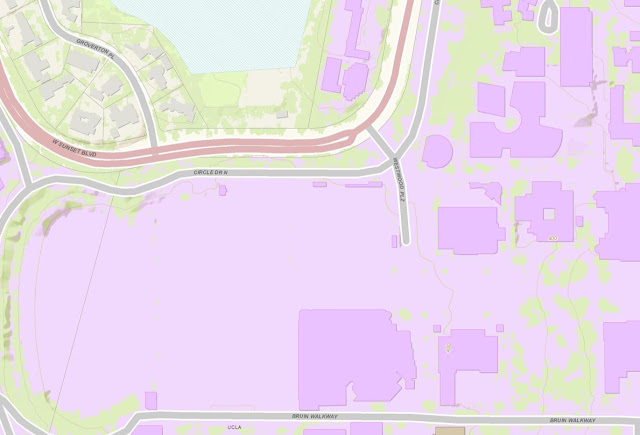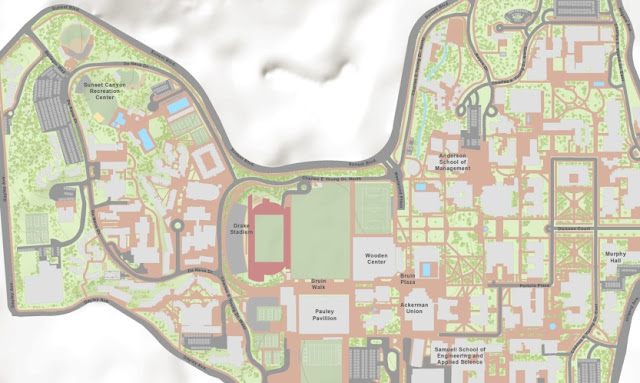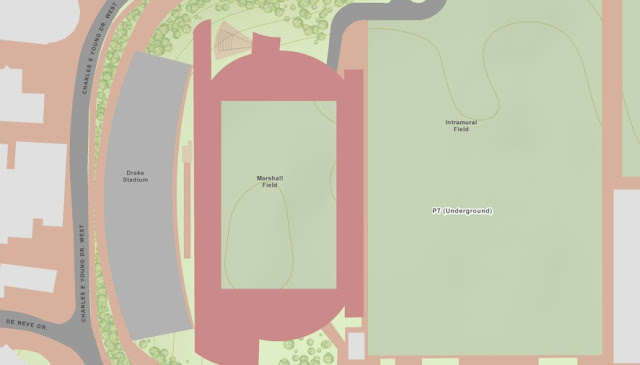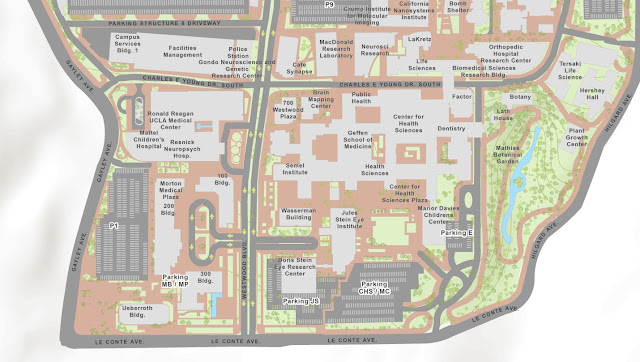Geography majors are lucky because
unlike other disciplines in the humanities, geographers get the unique
opportunity to specialize in Geographic Information Systems (GIS), a powerful
technological tool used in just about every industry. GIS is a highly
marketable skill that directly translates into a career path.
After completing the GIS minor at
UCLA, I got the chance to put all of the skills I learned to the test during my
summer internship at Esri, one of the world’s largest innovators in GIS
technology. During my time at Esri, I
found shocking holes in my GIS education. I could not believe that some of the
largest trends in the industry were almost completely ignored from my
curriculum. I quickly realized that if I wanted to make GIS into a career, I
would have to supplement my UCLA education with some more specialized
knowledge. That’s when I decided to ask almost everyone I talked to at Esri
this question:
“What are the most
marketable skills for a GIS Professional?”
I
wanted to share the responses I received with other fellow GIS students and graduates
so that they too could figure out where to focus their efforts beyond the basic
GIS fundamentals. Across the table, the same things came up over and over
again. Here are the top five marketable skills for a GIS Professional:
1. Web/Mobile is the largest trend in GIS. Web/Mobile technology takes GIS from the hands of millions to the hands of billions. From GPS navigation to location based apps, such as Waze Social GPS & Traffic, Foursquare and Shopkick, there is an enormous opportunity for employment and entrepreneurship. “Cloud computing” is the big buzz word in the geospatial community this year. The primary GIS technology to learn about is ArcGIS for Server, which will allow you to create, manage and distribute web and mobile GIS applications. The main obstacle for students who want to learn ArcGIS for Server is the lack of a Web GIS class offered to the student body. Upon graduating from UCLA, I took a course in Web GIS through UC Riverside Extension with one of the pioneers of web GIS, Esri’s Senior Web Applications Developer, Pinde Fu. I found the course to be valuable and I suggest that GIS students express a desire to their department to have a “Development for Web GIS” course added to their curriculum. You will need to learn about client-server applications and web architecture; this can be accomplished in an intro level Computer Science course in web technology. You will also need to gain some development skills such as learning how to use JavaScript, Silverlight or Flex APIs (Application Programming Interfaces) to create mashup applications (which dynamically combine content or functions from multiple Web sites). The best way to learn is to come up with an idea for an app and then develop it through trial by fire. To gain experience, I propose that some students develop this app idea that I came up with.
(Contributed by Brian Sims, Tom Wayson, Pinde Fu, Seth Sarakaitis, Mark Stewart, Ashley Pengelly, Lara McLaughlin, Tim Daly, Chris D’Amour)
2. Database Administration and Management are highly sought after skillsets; they are the glue that hold GIS together. In the working world, there are often multiple users working on the same geodatabase. That means that the data needs to be in a central repository so that the data can be simultaneously edited or used. Currently, the main technology to accomplish this is Esri’s ArcSDE. A budding technology to accomplish this is cloud storage; however there are still privacy issues surrounding the “cloud” solution. Different users of the data may require varied levels of permission to access different parts of the database. That is where a database administrator comes into play, the admin must have a working knowledge a Database Management System (DBMS) such as Oracle, SQL Server, SQL Server Express, MySQL or PostgresSQL (the last three mentioned are free). Another very important thing to learn is how to form Structured Query Language (SQL) statements. To gain familiarity with these highly marketable skills, take at least one intro level class in SQL and basic database administration. I suggest that GIS students express a desire to their department to have a “GIS Database Administration” course added to their curriculum.
(Contributed by Seth Sarakaitis, Mark Stewart, Tom Wayson, Brian Sims, Ashley Pengelly, BJ Swanner, Chris D’Amour)
3. Programming skills will set you apart from the rest of the pack. The automation of repetitive procedures will make you a more effective GIS Professional, especially in data intensive environments where a lot of geoprocessing needs to occur. The learning curve for programming is steep and requires a lot of upfront time investment before you will see a return on your efforts. Getting a strong technical grounding early in your career will make you a better communicator. Luckily, the best language for GIS is Python, which is relatively easy to learn compared to other programming languages. Not only are most ArcGIS geoprocessing tools built using python but a vast majority of big-name web services are built on python. This list includes Gmail, Google Maps, YouTube, reddit, Spotify, turntable.fm and Yahoo! Groups. Learning Python will be worth your time and once you know enough in one language, you can easily pick up other programming languages. I stumbled upon a course by a programmer who was fed up with the lack of resources to learn Python. He decided to write his own 200 page e-book called Real Python geared towards first time programmers. For $14, you can buy the e-book, receive hundreds of examples of code, and gain access to the course’s online member forum. This is great place to start.
If you are interested in web GIS development and building web apps, you should invest your time in learning JavaScript. The main advantage to JavaScript is that it is supported by all browsers so it can reach the largest amount of people. A good resource for learning JavaScript for free is Codecademy.
(Contributed by Greg Pleiss, Guy Noll, Lisa Stanners, Jaisudha Purushothaman, Pinde Fu, Lara McLaughlin, Tim Daly, Tom Wayson, Brian Sims, Matt Bottenberg)
4. IT knowledge – A GIS Professional is often the most technical member of a cross-disciplinary team. Because of this, GIS Professionals will often be looked to for their technical expertise even if the nature of an issue is well outside their job description. It is crucial for the GIS professional to become familiar with the fundamental technology that supports a GIS, including desktop and server operating systems and database management systems. The ability to troubleshoot both spatial data issues and also SQL security and server connections is often what separates a GIS analyst from a GIS professional. Consider taking an introductory course in Information Technology (IT) as well as following trends in technology. (contributed by BJ Swanner)
It is important to gain some equipment expertise. As a GIS Professional, your main job will be to work with data and you will need to be knowledgeable of how that data is created (ex. GPS, Trimble, EchoSounder, etc). If you can answer what makes the data collection method good and what makes it bad, then you are on the right track. (contributed by Guy Noll, Matt Bottenberg)
5. Interpersonal skills are critical in the work place. You need to be able to communicate with large spectrum of people, from non-technical clients to highly technical developers. This skill is intangible but crucial to your success as a GIS Professional. When a GIS professional possesses a unique combination of technical skill and interpersonal skills, they tend to rise up through organizations very quickly. This role as “information liaison” is a coveted position and very marketable. The 80/20 rule of interpersonal skills says that GIS work is 80% relationships and 20% technology. Whenever you have opportunities to work in groups and make presentations, take them!
(Contributed by Doug Cribbs, Greg Pleiss, Bill Earnshaw, Daryl Smith, Mike Wilbern, BJ Swanner).
Keep in mind that these top 5
marketable skills are above and beyond the basic GIS fundamentals.
The list is intended to be a guide for students who are already working towards
a concentration in GIS, who are looking for ways to set themselves apart from
the rest of their competition. You will notice that these top marketable skills
are much more related to Computer Science than to Geography. Consider taking on
a second minor in Computer Science (CS) or taking supplemental coursework at a
community college.
A lot of people think of GIS as
just a tool that they will use in some other field. This is fine if you want to be a professional
in another field, but if you want to be a GIS Professional then you should put
in the extra hours to learn some Computer Science skills (contributed by Brian
Sims).
In conclusion, college GIS courses
typically teach students the skills to perform GIS analysis. Students interested
in pursuing a career in GIS will need to augment those skills with broader IT
and CS skills including data management, IT infrastructure (virtualization,
etc), and programming. If you take the time to strengthen your abilities in
these areas, you will surpass your competition (contributed by Tom Wayson).



















































